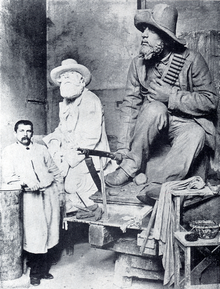Van Wouw Museum
He had training in academic sculpture in Europe, initially in the studio of the Belgian sculptor Joseph Graven (1836–1877), later through evening classes at the Rotterdam Academy, and also working alongside other Stucco workers such as Vielvoije.[2] When Anton van Wouw arrived in South Africa from the Netherlands, he was twenty-eight years old.[6] In The Sleeping African of 1907,[7] the subject is totally relaxed, fast asleep with mouth open and head slightly tilted to the right.With dignity and respect, Van Wouw sculptured King Khama, head of the Bamangwatu.The Van Wouw House, which was completed in 1938, shows the personal style that Norman Eaton had already developed at the time.The house itself was built with face brick, has a thatch roof and wooden window frames with shutters.The sound of water in the fishpond, climbing plants and lush gardens link the dwelling to the surrounding landscape.During the 25th Annual General Meeting of the Rembrandt Group on 16 November 1973, Dr Anton Rupert announced that a sum of money equal to the selling price of the property had been given to the University of Pretoria to purchase the Van Wouw House.

Brooklyn, PretoriaSouth AfricaSculpturemuseumAnton van WouwDriebergenUtrechtNetherlandsEuropeRotterdam AcademystuccoAfrican peoplebronze sculptureUniversity of PretoriaNorman EatonPretoria, South AfricaChancellorWiseman NkuhluVice-ChancellorCheryl de la ReySouth African School of MinesTransvaal University College Merensky LibraryKya RosaGordon Institute of Business ScienceFaculty of Engineering, the Built Environment and Information TechnologyVeterinary ScienceAfrican Centre for Gene TechnologiesForestry and Agricultural Biotechnology InstituteCentre for Human RightsLibrarySpecial CollectionsUPSpaceMapungubwe CollectionVan Gybland-Oosterhoff CollectionVan Tilburg CollectionBotanical GardenKalafong HospitalOnderstepoort Veterinary Academic HospitalSteve Biko HospitalWeskoppies Psychiatric Hospital HatfieldTuks FMUniversity of Pretoria F.C.Tuks LadiesTuks WomenFNB Varsity CupTuks Rugby LeagueTuks StadiumTuks Cricket OvalPretoriaTshwaneTimelinePretoria City HallUnion BuildingsVoortrekker MonumentPretoria FortsState TheatrePalace of JusticeOu RaadsaalSacred Heart CathedralDitsong MuseumsNational Museum of Natural History (Transvaal Museum)National Museum of Cultural History (African Window)Pionier MuseumSammy Marks MuseumTswaing Meteorite Crater MuseumKruger HouseWillem Prinsloo Agricultural MuseumFreedom ParkMelrose HouseAir Force MuseumPretoria Art MuseumChurch SquarePretoria National Botanical GardenBurgers ParkNational Zoological Gardens of South AfricaHeroes' AcrePretoria RosariumGroenkloofFountains ValleyKlapperkopWonderboomFaerie GlenBen Schoeman FreewayPretoria BypassMetropolitan routes in PretoriaPlatinum HighwayStatue of Paul KrugerStatue of Nelson Mandela